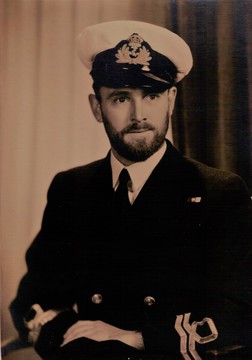OSBORNE, Alexander James
| Service Number: | PA/V/11 |
|---|---|
| Enlisted: | 19 September 1940, Port Adelaide |
| Last Rank: | Lieutenant |
| Last Unit: | HMAS Torrens (Depot) / HMAS Encounter (Shore) |
| Born: | Semaphore, South Australia, 9 October 1914 |
| Home Town: | Not yet discovered |
| Schooling: | Largs Bay Primary School and St Peters College, South Australia |
| Occupation: | Bank Officer |
| Died: | Heart Attack, Victor Harbour, South Australia, 22 September 2001, aged 86 years |
| Cemetery: |
Centennial Park Cemetery, South Australia Garden of Remembrance Wall 12, Row F |
| Memorials: | Hackney St Peter's College WW2 Honour Roll |
World War 2 Service
| 19 Sep 1940: | Involvement PA/V/11, HMAS Torrens (Depot) / HMAS Encounter (Shore) | |
|---|---|---|
| 19 Sep 1940: | Enlisted Port Adelaide | |
| 19 Sep 1940: | Enlisted Royal Australian Navy, Lieutenant, PA/V/11 | |
| 13 Aug 1944: | Discharged |
An Eventful War
Alexander Osborne joined the Royal Australia Navy Volunteer Reserve as a 25 year old in September 1940 under the Dominion Yachtsmen Scheme, a British Admiralty scheme whereby young men in the Dominions with yachting experience would be given fast-tracked commissions and serve as officers in the Royal Navy.
After training in the UK, he served as a gunner on the destroyer HMS Kashmir and was on the ship when it was sunk on 23 May 1941 by German dive-bombers during the Battle of Crete . The HMS Kelly, captained by Lord Louis Mountbatten, was also sunk in the battle and the survivors of both ships were machine-gunned by the Germans while being rescued.
One of Alex's fellow Australian "yachtie" officers, Ian Rhodes, was also aboard the HMS Kashmir. He was manning an anti-aircraft gun as the ship was sinking and shot down one of the German planes machine-gunning survivors. He was awarded the Conspicuous Gallantry Medal for his bravery, the only one ever awarded to an Australian.
Having completed his training and undertaken service at sea, he was appointed Sub-Lieutenant RANVR by the Lords Commissioners of the Admiralty in January 1942.
He then served as an officer on HMS Newcastle, a Town Class Light Cruiser, on convoy duty in the South Atlantic. The ship then joined the Eastern Fleet based at Bombay to stem the eastern advance of the Japanese navy and was then redeployed to Alexandria to reinforce the Mediterranean Fleet.
It was on convoy duty on 15 June 1942 when the ship was hit by a torpedo from a German U-boat. The blast blew a 30 foot hole right through the ship causing extensive damage but the ship did not sink and it eventually made it back to port. It was heavily reinforced and eventually sent to New York for repairs.
Alexander Osborne then served on Harbour Defence Motor Launches (HDMLs), Motor Launches (MLs), Motor Torpedo Boats (MTBs) and Motor Gun Boats (MGBs) in the Eastern Mediterranean.
In January 1943 he was promoted to Lieutenant RANVR.
After nearly 2 years in the Easter Mediterranean on small motor boats the stress was beginning to show and towards the end of 1943 he was diagnosed with "Anxiety Neurosis". In February 1944 his service with the Royal Navy was terminated and he was to be repatriated back to Australia.
Alexander Osborne was aboard the Norwegian merchant ship MV Tarifa on the voyage back to Melbourne on 7 March 1944 when the ship was torpedoed by a German U-Boat and sunk off the Horn of Africa. The survivors spent 7 days at sea clinging to rafts and wreckage before being spotted by an aircraft and eventually rescued.
He eventually arrived back in Adelaide and served at HMAS Torrens, a land base at Port Adelaide, for a short period before being honorably discharged as Physically Unfit for Naval Service on 13 August 1945.
On his discharge from the navy he resumed his career with The Bank of Adelaide (later taken over by the ANZ Bank), got married and had 3 children.
He died on 22 September 2001 at the age of 86
Submitted 24 September 2022 by James Osborne









